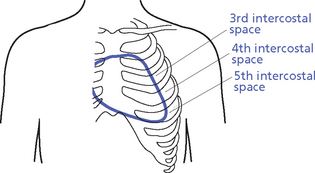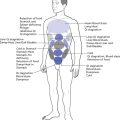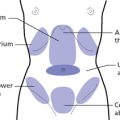 OBSERVATION OF THE HEARTBEAT
OBSERVATION OF THE HEARTBEAT
INTRODUCTION
Observation of the heartbeat refers to observation of the pulsation of the left ventricle. In surface anatomy the left ventricle of the heart forms the organ’s left border and produces the apical impulse, that is, the heart systolic beat, which can be felt in the fifth intercostal space, 7 to 9 centimetres from the midsternal line and either on the midclavicular line or just medial to it (Fig. 13.1). Although the pulsation of the left ventricle can always be felt on palpation, it cannot be observed under normal circumstances: it is only when there is a pathological state of the heart that the beat becomes visible on observation. Tangential lighting helps to detect an abnormal pulsation.

Fig. 13.1 Location of the apical beat
The pulsation of Xu Li
The heartbeat of the left ventricle, which can be felt in the fifth intercostal space, was called Xu Li in ancient Chinese medicine, which is another name for the Great Connecting channel of the Stomach. This channel cuts through the diaphragm and the lungs and exits below the left breast producing the heartbeat. It is also said to be the area where the Gathering Qi (Zong Qi) converges. The Gathering Qi itself is said to govern the two channels.
The Xu Li is described in Chapter 18 of the ‘Simple Questions’, which says: ‘The Great Connecting channel of the Stomach is called Xu Li. It cuts through the diaphragm and connects with the lungs, it exits below the left breast and its beat is the beating of the Gathering Qi.’1 It is interesting therefore that, although the pulsation in the fifth intercostal space is obviously the pulsation of the left ventricle, in Chinese medicine it is also related to the Stomach and for this reason the Stomach channel has an important influence on the heart (both in a Chinese and a Western sense) and especially the heart rhythm. Besides the Stomach, the apical beat is also related to the Lungs, as it reflects the ‘beating’ of the Gathering Qi.
A more detailed description of the symptoms and signs related to each pattern will be given in Part 5, Chapter 63.

 ). People’s Health Publishing House: Beijing, 1979:111 First published c. 100
). People’s Health Publishing House: Beijing, 1979:111 First published c. 100


